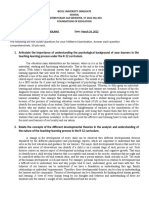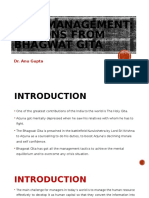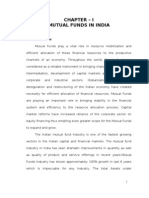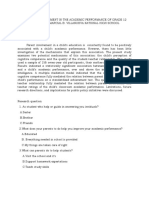Stress Management in The Context of Bhagavad-Gita: Dr. Kallave Maheshwar Gangadharrao
Stress Management in The Context of Bhagavad-Gita: Dr. Kallave Maheshwar Gangadharrao
Uploaded by
1986anuCopyright:
Available Formats
Stress Management in The Context of Bhagavad-Gita: Dr. Kallave Maheshwar Gangadharrao
Stress Management in The Context of Bhagavad-Gita: Dr. Kallave Maheshwar Gangadharrao
Uploaded by
1986anuOriginal Title
Copyright
Available Formats
Share this document
Did you find this document useful?
Is this content inappropriate?
Copyright:
Available Formats
Stress Management in The Context of Bhagavad-Gita: Dr. Kallave Maheshwar Gangadharrao
Stress Management in The Context of Bhagavad-Gita: Dr. Kallave Maheshwar Gangadharrao
Uploaded by
1986anuCopyright:
Available Formats
Aayushi International Interdisciplinary Research Journal (AIIRJ)
Vol - I Issue - I June 2014
Stress Management in the Context of Bhagavad-gita
Dr. Kallave Maheshwar Gangadharrao
Assistant Professor
Department of Education
Dr. Babasaheb Ambedkar Marathwada University,
Sub- Campus, Osmanabad
Email: maheshkallawe@gmail.com
Introduction:
Today, the concept of 'knowledge explosion' is taking roots in the educated
society, which has put on the garb of Information Technology and technology. But in
the current situation, instead of a conducive atmosphere, adverse atmosphere is
being created. This is exemplified by the increasing number of suicides committed by
students and increasing tendency of students towards addiction. If we probe deeply
into this aspect, we observe that the aspects which have become prominent today
are competition, spread of media, change in day-to-day lifestyle, bad habits, fear etc.
What lies at the root of all these happenings is nothing but stress. Today mental
stress is becoming an integral part of each individual's life and its outcomes are seen
in the form of suicides in a tender age, physical ailments and addiction. Even though
today's education system is modernized and is gaining momentum, yet we have
moved a little farther from the basic purpose of education and hence each student is
exposed to the problem of stress. The students are finding it difficult to cope with it
and this has led to a number of problems. In order that students overcome this
problem and become an able member of empowered India, the concept of life skill
education is introduced in education system. The govt. is making attempts so that
these life skills are not only covered in syllabus but are also found in a number of
treatises.
Through the present paper, we are going to explore how one of the life skills,
i.e. stress management gets reflected in the Bhagvad-gita.
Student hood and Effects of Stress:
1. Goal Setting Difficulties in setting goals, objectives, purposes and
action
2. Determination To get depressed at minor happenings.
3. Self Learning Divergence from real life experiences
Email ID’s Website Page No.
editor@aiirjournal.com www.aiirjournal.com [1]
Aayushi International Interdisciplinary Research Journal (AIIRJ)
Vol - I Issue - I June 2014
4. Self Confidence Unaware about one’s own capabilities
5. Creativity Emphasis on mechanical actions
6. Discipline Arrogance at a subtle level
7. Making Efforts Escapism taking place of the attitude of making efforts
8. Optimism Action from the perspective ‘I don’t have an impact at
my individual level’.
On considering the above aspects, we come to know that stress impacts the
internal character / personality of a student rather than his external persona. This
introduces problems in the learning abilities of students. Now-a-days, a number of
solutions for managing stress are being discussed. Through such measures as
yogasanas, pranayamas, camps etc., the role of stress management is being made
clear. Through the present research, I have delved deeply as to how we find the
references / solutions for stress management in the Bhagavad-gita.
Chief Reasons of Stress:
1) Mere day-dreaming (excessive indulgence in day dreaming rather than
acting)
2) Holding situation to be responsible for one’s failure etc.
3) Pessimism (lack of confidence in one’s own capabilities)
4) Excessive dependence on instruments (according to this outlook,
instruments are not for our service, in fact, we have become their slaves)
5) Dominance (to find oneself in domineering position by finding faults in
others/ belittling others)
Email ID’s Website Page No.
editor@aiirjournal.com www.aiirjournal.com [2]
Aayushi International Interdisciplinary Research Journal (AIIRJ)
Vol - I Issue - I June 2014
Prevalent Situation of Stress and what Corrective Measures are Suggested in the
Bhagavad-gita:
Sr. Prevalent Situation Role of the Bhagavad-gita in Stress
No. Management
1 Mere day Dreaming: This -ism makes Making Efforts: Instead of indulging in
life stagnant. In this situation, only day-dreaming, the Bhagavad-gita has
success of a successful person is seen elaborated the importance of making
and not the effects of success. Hence, efforts. A thing gained after making
student keeps day-dreaming. efforts brings satisfaction. Moreover, the
Bhagavad-gita explains that one should
have trust in the efforts one is taking to
be successful.
2 Blaming a Situation: Not only students The Role of your Own Self: The
but all of us blame situation for what Bhagavad-gita advocates that it is me
we are or simply when we face failure, who is responsible for my own actions,
we place the blame on situation. Even success and my failure. In the Gita, ample
Marx and Freud showed inclination examples are given where man has
towards this tendency. overcome situation. The Gita elaborates
as how to keep aside failure in the past
and to dwell in the present only.
3 Pessimism – The tendency that on my Optimism: In the Bhagavad-gita,
own, I am helpless and won’t be able to optimism is taught. It has advocated that
achieve something. I’ll even put up with if we combine idealism with realism, we
slavery, but I need security. can keep hope alive in our lives.
4 Over-dependence on Instruments: This Emotionalism: Instruments should be as
aspect leads us nowhere. Today, there means and not as ends in themselves.
is over- abundance of instruments. The Gita explains that as these
Rather than getting service from them, instruments are necessary, so also is the
we have to look after them and thus we attachment (emotionalism) to these is
become their slaves. needed.
5 Dominance: An individual loses his Superiority of the Absolute Power: The
balance due to dominance. Dominance Gita explains that as I have my own
gives birth to the strong feeling that as dignity, so others also have dignity.
others have access to material Self Respect + Respect for others =
pleasures, so I should also possess these Dignity for Mankind
pleasures. Thus, the Gita underlines the superiority
of the absolute (divine) power.
The Role of the Bhagavad-gita in Stress Management:
We have heard about references, abstracts, and examples etc. from the
Bhagavad-gita a number of times. Then we come across questions such as what is
the theme of the Gita? For whom is it relevant? Whether the Gita should be looked
Email ID’s Website Page No.
editor@aiirjournal.com www.aiirjournal.com [3]
Aayushi International Interdisciplinary Research Journal (AIIRJ)
Vol - I Issue - I June 2014
at as a treatise or a religious book? When we begin to delve deep into our own
selves, the Gita presents before us the answers to questions and we come to know
that it is a treatise explaining the mysteries of life (‘guhayatam shastram’).
1. Goal setting and the Gita: The Gita has explained 4 ways of goal setting;
1) Broadness of the Goal 2) Focus on the Goal
3) Fineness of the Goal 4) its purity.
If we don’t have a definite goal before us, our efforts go wasted and
knowledge proves to be useless. Hence, guiding principles have been elaborated on
in the Bhagavad-gita.
2. Firmness and the Gita: The Gita gives the message ‘Nothing is gained without
making efforts. Efforts made are not wasted. Do your karma and ask for blessings/
help and you will get the help’. This guidance helps one to remain firm in life. When
one becomes concerned about the outcome of one’s actions, it then merely
becomes a desire. By giving the cardinal principle ‘karmanye vadhikaraste ma
phaleshu kadachan’, the Gita explains the concept of eternal truth in this world.
3. Today, escapism amongst people is on rise and as a result, desperation is equally
on rise. But the Gita lays emphasis on making efforts/ performing one’s karmas as
told in the principle ‘uddhare datmanamanam natmanamwasayadet’.
4. When one takes birth in this world, it is but natural that somebody will be superior
to you and somebody will also be inferior to you in some or the other way, e.g. age,
knowledge etc. This leads to the tendency of considering oneself to be dominant /
superior to others and this tendency leads to conflicts in one’s personality. In the
Gita, this faulty thinking pattern is corrected by elaborating on maintaining self-
respect and at the same time, respect for others. The Gita explains that if an
individual knows that it is only He (the God) who is great, then there would arise no
conflict.
5. If an individual lacks in self-esteem, then one becomes hapless and surrenders to
the passions and desires and this gives rise to a feeling of helplessness and ultimately
this creates tension in the mind of the person. By explaining us the concept of ‘self-
esteem’, the Gita suggests to us to recognize ourselves. Similarly, the Gita advocates
us not to beg and not to get disappointed. The Gita has also explained that ‘I’ve the
ability to work’ and thus has introduced self-esteem to us.
Conclusion:
In today’s age of computers, it is not sufficient to impart only knowledge to
students, but what is more required is how the knowledge is imbibed and how
Email ID’s Website Page No.
editor@aiirjournal.com www.aiirjournal.com [4]
Aayushi International Interdisciplinary Research Journal (AIIRJ)
Vol - I Issue - I June 2014
students’ personality undergoes development through the knowledge gained. For
this to happen, life needs to be free from stress. This state of carefree attitude helps
students in inculcating other life skills. As a result, students turn to creativity, solve
problems easily and maintain the feelings of sympathy and empathy to others. But
for this to happen, they need to be stress-free in the first place. The Gita has
explained this way of leading stress-free life in an easy and lucid manner. If students
follow this path, them imbibing other life skills becomes very much easy for them.
References:
Dravid, Narayanshashtri (2009) Bharatiya Tatvadyanaatil Pramaanmimaansa.
Nagpur: Ramkrushna Math.
Thakkar, Haribhai (2012) Theory of Karma. Ahamadabad: Kusum Publication
Krushnakrupamurti (2011) Bhagvat-gita As It Is. Mumbai: Bhakat Vedant Book Trust
Tatvadyan Marathi Journal (Issue: Sep, Oct, Nov-2003, Apr-2006, Aug-2009, May-
2011, Apr-2012, Feb -2013) Mumbai: Satvichar Darshan ‘Nirmal Niketan’
Email ID’s Website Page No.
editor@aiirjournal.com www.aiirjournal.com [5]
You might also like
- PED3701 Assignment 2Document12 pagesPED3701 Assignment 2Jonèl Maree100% (3)
- Module 8 - Facilitating Learner - Centered TeachingDocument4 pagesModule 8 - Facilitating Learner - Centered TeachingSheila Mae Paltep100% (6)
- Research Topics SummaryDocument36 pagesResearch Topics SummaryNora HerreraNo ratings yet
- Neuro Motor Readiness Pl2011Document94 pagesNeuro Motor Readiness Pl2011mohitnet1327100% (4)
- Stress Managemant ModuleDocument21 pagesStress Managemant ModuleTuTitNo ratings yet
- ELEMENTS OF THE SELF-EFFICACY MODEL BY BANDURA YyfcDocument1 pageELEMENTS OF THE SELF-EFFICACY MODEL BY BANDURA YyfcYARELY YAMILETH FLORES COTANo ratings yet
- Ihomeroom Guidance Module 1Document6 pagesIhomeroom Guidance Module 1Mark John BetitoNo ratings yet
- 1 Self-Efficacy - Why Believing in Yourself MattersDocument1 page1 Self-Efficacy - Why Believing in Yourself MatterszozimeziNo ratings yet
- Albert Bandura Self EfficacyDocument15 pagesAlbert Bandura Self EfficacyJhener Nonesa100% (1)
- Unds111 Notes FinalsDocument3 pagesUnds111 Notes FinalsShaniqua ValderamaNo ratings yet
- UNDSDocument2 pagesUNDSskyNo ratings yet
- Self - Efficacy and Self - Concept Belief Among Students in MNHS Background of The StudyDocument4 pagesSelf - Efficacy and Self - Concept Belief Among Students in MNHS Background of The StudyJoshua LicopaNo ratings yet
- WEEK-9-IN-PYCHOLOGICAL-THEORIESDocument19 pagesWEEK-9-IN-PYCHOLOGICAL-THEORIESnicoleogayon223No ratings yet
- Bandura EffectsDocument5 pagesBandura EffectsDandy Ramos Lood100% (1)
- mindfulnessinthworkplaceDocument9 pagesmindfulnessinthworkplaceknightkyo00No ratings yet
- English. Path To WellbeingDocument115 pagesEnglish. Path To WellbeingAdina IgnatNo ratings yet
- THESELF MODULE 5-6Document25 pagesTHESELF MODULE 5-6jessamaeilagNo ratings yet
- Acogido, Manuel Paulo Midterm FoundationsDocument4 pagesAcogido, Manuel Paulo Midterm FoundationsManuel Paulo AcogidoNo ratings yet
- UTS Group 9Document84 pagesUTS Group 9Mary Allysa ArroyoNo ratings yet
- Answers of Learning Journal 2Document31 pagesAnswers of Learning Journal 2Azmi BahariNo ratings yet
- Chapter 2Document27 pagesChapter 2dillajohan06No ratings yet
- Topic 10 - Motivation and LearningDocument16 pagesTopic 10 - Motivation and LearningTESL110621 Nur Zulaikha Binti ZahrollailNo ratings yet
- DLL Matatag - Pe&health 4 Q1 W1Document15 pagesDLL Matatag - Pe&health 4 Q1 W1Roswel Placigo100% (1)
- Assessment 1.2Document3 pagesAssessment 1.27zsjkkyyfnNo ratings yet
- Sas#21-Gen 002Document8 pagesSas#21-Gen 002Nishina Aicy ArellanoNo ratings yet
- Chapter Iii: Managing and Caring For The Self B. Setting Goals For SuccessDocument9 pagesChapter Iii: Managing and Caring For The Self B. Setting Goals For Successzed cozNo ratings yet
- Written Assignment. Unit 5Document3 pagesWritten Assignment. Unit 5Niki PanoutsakouNo ratings yet
- A Study On Occupational Stress Experienced by Working Women in Management Colleges of Bput, OdishaDocument8 pagesA Study On Occupational Stress Experienced by Working Women in Management Colleges of Bput, OdishaarcherselevatorsNo ratings yet
- Irjet Effect of Yoga Asana On Self EsteeDocument6 pagesIrjet Effect of Yoga Asana On Self Esteedeepikanarasimhan1No ratings yet
- Self-Efficacy TheoryDocument13 pagesSelf-Efficacy TheoryEmir ŠkrijeljNo ratings yet
- Banduras Self Efficacy ReportDocument19 pagesBanduras Self Efficacy ReportRhona ParasNo ratings yet
- PE&HEALTH-7-WSW-Q2-W2-2024-2025-T.GraceDocument5 pagesPE&HEALTH-7-WSW-Q2-W2-2024-2025-T.Gracejeffrey.agustin13No ratings yet
- Self Efficacy Theory - PresentationDocument5 pagesSelf Efficacy Theory - PresentationNaveed DaarNo ratings yet
- 23 Resilience Building Tools and Exercises (+ Mental Toughness Test)Document42 pages23 Resilience Building Tools and Exercises (+ Mental Toughness Test)gyarmati.zsuzsa826100% (1)
- GE108 Unit3Topic3ProductivityDocument7 pagesGE108 Unit3Topic3Productivity2301105333No ratings yet
- Self EfficacyDocument4 pagesSelf EfficacySainaath Jandhhyaala100% (1)
- UTS Module - DO NOT JUST DREAM MAKE IT HAPPENDocument10 pagesUTS Module - DO NOT JUST DREAM MAKE IT HAPPENSarah TolentinoNo ratings yet
- Teens Managing Lifes ExpectationsDocument140 pagesTeens Managing Lifes ExpectationsAlexandra100% (1)
- Impact of Meditation On Leadership SkillsDocument11 pagesImpact of Meditation On Leadership Skillsaol.ambarishNo ratings yet
- Importance of Yoga For School Going ChildrenDocument5 pagesImportance of Yoga For School Going ChildrenrobahejebNo ratings yet
- Lippke 2017Document6 pagesLippke 2017comenius2014No ratings yet
- Group Assignment - MotivationDocument19 pagesGroup Assignment - MotivationTruong Dinh Phu (K14 HCM)No ratings yet
- Managing Outer AtmosphereDocument4 pagesManaging Outer AtmosphereIjcams PublicationNo ratings yet
- Social Cognitive Theory: What Is Self-Efficacy?Document2 pagesSocial Cognitive Theory: What Is Self-Efficacy?kerang73No ratings yet
- Review of MindsetDocument10 pagesReview of MindsetYusif KoromaNo ratings yet
- Assignment 5Document5 pagesAssignment 5sooraopenNo ratings yet
- Mental ModelsDocument46 pagesMental ModelsYavnish Garg100% (1)
- Stress Management in The Banking Sector PDFDocument5 pagesStress Management in The Banking Sector PDFLaxmi100% (1)
- THC6 Module-1Document17 pagesTHC6 Module-1dainyruthjuntilloNo ratings yet
- 137-Article Text-347-1-10-20230221Document8 pages137-Article Text-347-1-10-20230221abueza54No ratings yet
- Mini Skrip Kel.21Document16 pagesMini Skrip Kel.21Siska Puspita NelyNo ratings yet
- Self-Efficacy, Self-Regulation, and Goal SettingDocument156 pagesSelf-Efficacy, Self-Regulation, and Goal Settingjohn mark tumbagaNo ratings yet
- CbsehappyclassroomDocument6 pagesCbsehappyclassroombabashaheedschoolNo ratings yet
- Psychology of EfficacyDocument3 pagesPsychology of EfficacyScott BramerNo ratings yet
- 239-Article Text-576-1-10-20211123Document7 pages239-Article Text-576-1-10-20211123Muhammad Yassar AryasenaNo ratings yet
- 5 - 13 - 2017 5 - 19 - 24 PM - Content With HeadingDocument42 pages5 - 13 - 2017 5 - 19 - 24 PM - Content With Headingsharfaa35zaveriNo ratings yet
- BhagwatgeetapdfDocument4 pagesBhagwatgeetapdfsocioca2No ratings yet
- Artikel UAS PSI PEND Dini Dwi Anggraini - 2330306019 PSI ADocument9 pagesArtikel UAS PSI PEND Dini Dwi Anggraini - 2330306019 PSI Ailfi rahmiNo ratings yet
- QuestionnaireDocument7 pagesQuestionnaireElmer TaripeNo ratings yet
- Monitoring Independent Learning To Build Resilience 2Document21 pagesMonitoring Independent Learning To Build Resilience 2Ali PanjuNo ratings yet
- Unit 3 Human PsychologyDocument27 pagesUnit 3 Human PsychologyNavyaNo ratings yet
- A Study On The Importance of Yoga Education in B.Ed. CurriculumDocument3 pagesA Study On The Importance of Yoga Education in B.Ed. CurriculumPraveenNo ratings yet
- X-Mas New Year: CelebrationsDocument11 pagesX-Mas New Year: Celebrations1986anuNo ratings yet
- Day4 Residential Status and Incidence of Tax (9 Oct)Document12 pagesDay4 Residential Status and Incidence of Tax (9 Oct)1986anuNo ratings yet
- Overhead - Machine Hour RateDocument17 pagesOverhead - Machine Hour Rate1986anu100% (1)
- Grade 1 IMO in PDFDocument11 pagesGrade 1 IMO in PDF1986anuNo ratings yet
- Stress Management and GeetaDocument5 pagesStress Management and Geeta1986anuNo ratings yet
- 31st March Performance BudgetingDocument13 pages31st March Performance Budgeting1986anuNo ratings yet
- (Book Chapter) Risk-Analysis-in-Capital-BudgetingDocument49 pages(Book Chapter) Risk-Analysis-in-Capital-Budgeting1986anu100% (2)
- Self ManagementDocument22 pagesSelf Management1986anu83% (6)
- Foreign BanksDocument9 pagesForeign Banks1986anuNo ratings yet
- Advance TaxDocument2 pagesAdvance Tax1986anuNo ratings yet
- Presented By:: Shubham Bhutada Aurangabad (MH)Document30 pagesPresented By:: Shubham Bhutada Aurangabad (MH)1986anu100% (2)
- Venture CapitalDocument45 pagesVenture Capital1986anuNo ratings yet
- Sushil MundadaDocument20 pagesSushil Mundada1986anuNo ratings yet
- Public Sector BanksDocument1 pagePublic Sector Banks1986anuNo ratings yet
- Depository and Stock ExchangeDocument22 pagesDepository and Stock Exchange1986anuNo ratings yet
- Chapter - I Mutual Funds in IndiaDocument28 pagesChapter - I Mutual Funds in India1986anuNo ratings yet
- QuestionnaireDocument3 pagesQuestionnaire1986anuNo ratings yet
- Inclusive GrowthDocument8 pagesInclusive Growth1986anuNo ratings yet
- Delivering Your MessageDocument14 pagesDelivering Your MessageDania ShalanNo ratings yet
- True or FalseDocument26 pagesTrue or Falsebaonq.qcNo ratings yet
- Satire RubricDocument1 pageSatire RubricKatcho3No ratings yet
- Reviewer in DIASS For 2nd Quarter ExaminationDocument2 pagesReviewer in DIASS For 2nd Quarter Examinationjoel50% (2)
- THE Shepherd'S DaughterDocument34 pagesTHE Shepherd'S DaughterMarra CantoriaNo ratings yet
- Starting AriesDocument4 pagesStarting Arieshelpdesk.kizunaNo ratings yet
- Basic Reading 400 Key Words 1 - TGDocument72 pagesBasic Reading 400 Key Words 1 - TGsophia.wangNo ratings yet
- BPSYDocument4 pagesBPSYHannahNo ratings yet
- Red White My Balls AreDocument67 pagesRed White My Balls AreBb VallejoNo ratings yet
- Module 5 NC II Contributing To Workplace Innovation FINALDocument60 pagesModule 5 NC II Contributing To Workplace Innovation FINALAl-juffrey Luis AmilhamjaNo ratings yet
- Eapp WK 4Document7 pagesEapp WK 4Mawii GiiNo ratings yet
- Business Communication Strategies: Analysis of Internal Communication ProcessesDocument23 pagesBusiness Communication Strategies: Analysis of Internal Communication ProcessesMamta AgarwalNo ratings yet
- Assessment Brief - AS2Document5 pagesAssessment Brief - AS2Mahendra paudel PaudelNo ratings yet
- 161 PDFDocument271 pages161 PDFNavneet KumarNo ratings yet
- LM03 Market Efficiency IFT NotesDocument8 pagesLM03 Market Efficiency IFT Notesekenemicheal29No ratings yet
- Beauty Is Always in The Eye of The BeholderDocument2 pagesBeauty Is Always in The Eye of The BeholderSagar MahmudNo ratings yet
- Handicap Blessing or CurseDocument3 pagesHandicap Blessing or Curseapi-3707924No ratings yet
- The Eucator's Guide To Design Thinking by The D. School StanfordDocument12 pagesThe Eucator's Guide To Design Thinking by The D. School StanfordRoy ereneaNo ratings yet
- CHARACTERISTICS OF THE 14 15 16-ConvertiDocument5 pagesCHARACTERISTICS OF THE 14 15 16-ConvertibassemNo ratings yet
- Speech Title: May Fifteen Edited/Revised Version Speech Editing PrincipleDocument5 pagesSpeech Title: May Fifteen Edited/Revised Version Speech Editing PrinciplePsyche Lycheee100% (1)
- 7 Decision-MakingDocument24 pages7 Decision-MakingAbera Mamo JaletaNo ratings yet
- 2021-2022 English II Reading Unit 2 CUA Test ID 96941Document11 pages2021-2022 English II Reading Unit 2 CUA Test ID 96941Andrea Garcia100% (1)
- Couple Therapy ChapterproofDocument11 pagesCouple Therapy ChapterproofRabwa . k. TNo ratings yet
- DR Georgina Warner Presentation at DSA DS ASD Meeting 4 October 2014Document22 pagesDR Georgina Warner Presentation at DSA DS ASD Meeting 4 October 2014Mariam TchkoidzeNo ratings yet
- Pt3 18-19Document17 pagesPt3 18-19tpbalajiNo ratings yet
- How Effective Is Peer Interaction in Facilitating Learning? A Meta-AnalysisDocument17 pagesHow Effective Is Peer Interaction in Facilitating Learning? A Meta-AnalysisMOHD IQMAL HARLEE ABDULLAH MoeNo ratings yet
- Parental Involvement in The Academic Performance of Grade 12 Students in Marcial BDocument3 pagesParental Involvement in The Academic Performance of Grade 12 Students in Marcial BAldrin EjurangoNo ratings yet











































































































